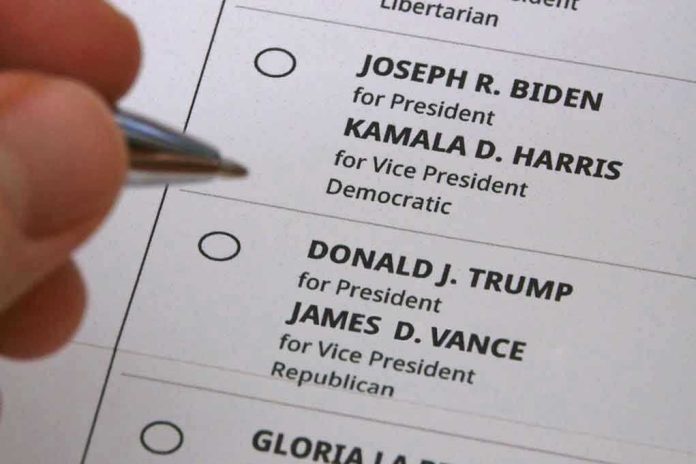
Ahead of the pivotal 2026 midterm elections, President Trump’s plan to ban mail-in ballots and voting machines signals a high-stakes battle over election integrity and federal authority, igniting fierce debate across the nation.
Story Snapshot
- President Trump announced an executive order to eliminate mail-in ballots and voting machines for the 2026 midterms.
- The move is framed as restoring election honesty but is expected to face major legal and constitutional challenges.
- State officials and advocacy groups are preparing to resist what they see as federal overreach into state-run elections.
- No official text of the executive order has been released; intense polarization and legal battles are anticipated.
Trump’s Push for Paper Ballots Sparks National Debate
On August 18, 2025, President Donald Trump declared his intent to sign an executive order that would eliminate the use of mail-in ballots and voting machines for the upcoming 2026 midterm elections. Trump argues that these voting methods are plagued by fraud and inaccuracy, calling for a return to paper ballots to restore what he describes as “honesty” and transparency in American elections. This announcement immediately drew national attention, setting the stage for a major confrontation over the future of U.S. voting procedures.
The President’s plan arrives months ahead of the midterms, underscoring a proactive effort to reshape the way Americans vote. Trump’s initiative directly challenges the decentralized nature of U.S. elections, where states have traditionally controlled voting methods. Notably, his assertion that states act as “agents” of the federal government in election matters marks a significant escalation in federal involvement. Many state officials, both Republican and Democrat, are expected to resist this move, viewing it as a threat to state sovereignty and long-standing electoral traditions.
Legal and Constitutional Challenges Loom
The legal landscape surrounding Trump’s executive order is fraught with uncertainty. The U.S. Constitution has historically granted states primary authority over election administration, making any federal intervention highly controversial and likely to be met with immediate legal challenges. Voting rights groups and state election officials are already signaling their intent to contest the order in court, arguing that it undermines accessible voting and exceeds executive power. With no official text of the executive order released as of this report, the specifics remain unclear, but the battle lines are firmly drawn.
Election security experts and bipartisan commissions have consistently found no evidence of widespread fraud in mail-in ballots or electronic voting machines. Despite these findings, Trump and his supporters maintain that stricter controls are necessary to safeguard election integrity. Critics, meanwhile, warn that the move could disenfranchise large groups of voters, especially the elderly, disabled, and military personnel who rely on mail-in options. The looming legal fight is expected to be swift and intense, with federal courts likely to play a decisive role in determining the order’s fate.
Impact on Voters, Elections, and Political Climate
If implemented, Trump’s executive order would fundamentally alter the administration of U.S. elections by reducing or eliminating mail-in voting and electronic tabulation. In the short term, legal challenges are likely to delay or block enforcement, creating confusion among voters and officials. Long-term effects could include a precedent for increased federal intervention in state elections and a shift toward more restrictive voting practices. The economic impact would be significant for the election technology sector, while politically, the country faces further polarization as both supporters and opponents mobilize around the issue.
Trump says he’ll sign order targetting mail-in ballots, voting machines ahead of 2026 midterms https://t.co/j9nfR9C9sF
— Breaking News (@jooilong) August 18, 2025
The announcement comes amid ongoing partisan battles over election integrity, with Trump’s supporters hailing the move as a necessary step to protect democracy and critics decrying it as an attempt to suppress votes. The debate over mail-in ballots and voting machines has become a flashpoint for broader concerns about constitutional rights, government overreach, and the balance of power between federal and state authorities. As the 2026 midterms approach, Americans can expect heightened scrutiny, legal wrangling, and continued debate over the very foundation of the nation’s democratic process.
Sources:
ABC News, “Trump says he will lead ‘movement’ to end mail-in voting,” August 18, 2025.
Le Monde, “Trump takes aim at mail-in ballots ahead of 2026 midterms,” August 18, 2025.



